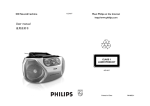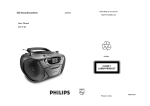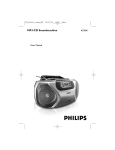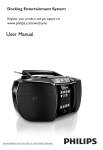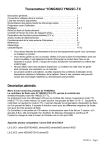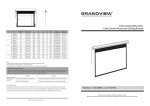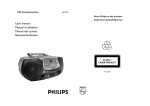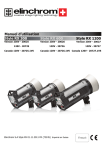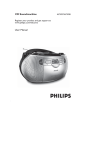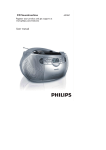Download Philips AZ1017 CD Soundmachine
Transcript
CD Soundmachine AZ1017 Meet Philips at the Internet http://www.philips.com W CLASS 1 LASER PRODUCT AZ 1017 Printed in China JH-0607 1 7 2 1 2 3 4 8 9 3 5 6 7 0 4 X ! 5 # @ $ 6xR14•UM-2•C-CELLS 6 C REPEAT ALL B A A English Controls/Power Supply Supplied accessories $ p – 3.5 mm stereo headphone socket – AC power cord Helpful hints: The speakers will be muted when headphones are connected to the set. % AC MAINS – inlet for power cord ^ Voltage selector – adjust to match the local voltage 110/220V before plugging in the set Top and front panels (See 1) 1 Source selector: CD,TUNER, TAPE/OFF – selects CD, tuner (MW or FM) or tape source of sound – switch off the set CAUTION - Visible and invisible laser radiation. If the cover is open, do not look at the beam. - High voltage! Do not open.You run the risk of getting an electric shock. The machine does not contain any user-serviceable parts. - Modification of the product could result in hazardous radiation of EMC or other unsafe operation. 2 VOLUME – adjusts volume level 3 LIFT•OPEN – opens the CD door 4 MIC (built-in microphone) – for voice recording via cassette recording 5 Cassette recorder keys: ; – pauses playback or recording 9/ – stops the tape; – opens the cassette holder 5 or 6 – fast winds/ rewinds tape 1 – starts playback 0 – starts recording Power Supply 6 CD Display – shows the CD functions Whenever convenient, use the mains supply cord if you want to conserve battery life. Make sure you remove the plug from the set and wall outlet before inserting batteries. 7 PROG – programs and reviews programmed track numbers 8 REPEAT – repeats a track/ CD program/entire CD 9 BAND – selects FM or MW waveband 0 TUNING – tunes to radio stations ! 2; – starts or pauses CD playback. 9 – stop playback; – erases a CD program ∞, § – skips or searches a passage/track backwards 1 2 Back panel (See 1) # Battery compartment – open to insert 6 x 1.5V R-14/ UM2/ C-cells • • When inserting new batteries, do not try to mix old batteries with the new ones. • Remove the batteries if the set is not to be used for a long time. 1 Using AC Mains Check if the power/mains voltage, as shown on the type plate located on the bottom of the set, corresponds to your local power supply. If it does not, consult your dealer or service center. 2 If your set is equipped with a voltage selector, adjust the selector so that it matches with the local power supply. 3 Connect the power cord to the AC MAINS inlet and the wall socket.The mains lead is now connected and ready for use. 4 To switch the set off completely, withdraw the power cord from the wall socket. 5 Install the unit near the AC outlet and where the AC power plug can be easily reached. • Disconnect the mains lead from the wall socket to protect your set during heavy thunderstorms. Children could seriously injure themselves as the free end of the cable may still be live if only the connector is removed from the MAINS socket at the back of the unit. The type plate is located on the bottom of the set. Replace the compartment door, making sure the batteries are firmly and correctly in place. The set is now ready to operate. Incorrect use of batteries can cause electrolyte leakage and will corrode the compartment or cause the batteries to burst: Do not mix battery types: e.g. alkaline with carbon zinc. Only use batteries of the same type for the set. • Batteries (not included) Open the battery compartment and insert six batteries, type R-14, UM-2 or C-cells, (preferably alkaline) with the correct polarity as indicated by the "+" and "–" symbols inside the compartment. (See 1) Batteries contain chemical substances, so they should be disposed of properly. @ Telescopic antenna – improves FM reception Power Supply – Helpful hints : To avoid unnecessary energy consumption, always adjust the source selector to TAPE/OFF after using the set, and also check that the tape deck keys are released. Basic operation/Radio Basic operation 1 To select your sound source, adjust the source selector to : CD, TUNER or TAPE/OFF. 2 To switch off the set, adjust the source selector to TAPE/OFF position and check the cassette keys are released. – Helpful hints: To change from TAPE to TUNER or CD function, or when you are switching off the set: first, make sure you press the tape 9/ key to end playback and all the cassette keys are released. Adjusting volume Adjust the volume with the VOLUME control. Radio reception 1 Adjust the source selector to TUNER. 2 Adjust BAND to FM or MW as your desired band. 3 Turn TUNING to tune to a station. • For FM, extend and turn the telescopic antenna for best reception. Reduce its length if the signal is too strong. • For MW, the set uses a built-in antenna. Direct this antenna for best reception by turning the whole set. 4 To switch off the radio, adjust the source selector to TAPE/OFF position and check the cassette keys are released. CD Player CD Player Playing a CD • • Press ∞ or § once or repeatedly until the desired track number appears in the display. MP3 CD-ROMs, CD-I, CDV,VCD, DVD or computer CDs are not possible for playback on this set. • In the stop/pause position, press 2; to start playback. IMPORTANT! • CDs encoded with copyright protection technologies by some record companies may be unplayable by this product. 1 Adjust the source selector to CD. 2 Open the disc door. 3 Insert a CD with the printed side facing up and press the CD door gently to close. ➜ Display shows -- and later, the total number of tracks. (See 2, 3) Press 2; on the set to start playback. ➜Display: 2 and the current track number. (See 4) 4 5 To pause playback press 2;. To resume playback, press 2; again. 6 To stop CD play, press 9. – – Helpful hints : CD play will also stop when: you open the CD compartment; you select TUNER, or TAPE/OFF sound source; the CD has reached the end of playback. – Selecting a different track This CD player plays Audio Discs including CD-Recordables and CD-Rewritable. 1 Finding a passage within a track 1 2 – During playback, press and hold down ∞/ §. ➜ The CD is played at high speed and low volume. When you recognize the passage you want release ∞/ §. ➜ Normal playback resumes. Helpful hints : When your searching reaches the end of the last track, the CD goes to stop mode. 2 3 Programming track numbers Different play mode: REPEAT(see 6): You may store up to 20 tracks in the desired sequence. If you like, store any track more than once. REPEAT You can play the current track or the whole disc repeatedly, and combine REPEAT modes with PROGRAM. In the stop position, press PROG to activate programming. ➜ Display: PROG and 00 flash (see 5). Press ∞ or § to select your desired track number. ➜ Display: PROG and your desired track number flash. Press PROG to store the desired track number. ➜ Display: PROG and 00 flash for you to program the next track. 4 Repeat steps 2 to 3 to select and store all desired tracks in this way. 5 To play your program, press 2;. ➜ Display: PROG flashes during program playback. Helpful hints : – If you try to store more than 20 tracks, no track can be selected and the display will show flashing --. • To review a program In the stop position, press PROG repeatedly to see your stored track numbers. Erasing a program You can erase the contents of the memory by: – in the stop position, press PROG to enter program mode, and then press 9; – Selecting TUNER or TAPE/OFF sound source; – opening the CD door. ➜Display: PROG disappears. REPEAT – plays the current track continuously. REPEAT ALL– repeats the entire CD/program. 1 To select play mode, press REPEAT once or more. ➜ The display shows selected mode. 2 Press 2; to start playback if in the stop/pause position. 3 To return to normal playback, press REPEAT repeatedly until the modes are no longer displayed. – You can also press 9 to cancel your play mode. Cassette Recorder Cassette playback 1 2 3 4 5 6 1 2 – – • • • • Adjust the source selector to TAPE/OFF. Press 9/ to open the cassette holder, and insert a cassette and close the deck. Press 1 to start playback. To pause playback press ;. To resume, press ; again. To stop the tape, press 9/. Fast forwarding/rewinding Press 5 or 6 until you reach your desired passage. Press 9/ to stop rewinding/fast forwarding. Helpful hints : The keys are automatically released at the end of a tape and the set is switched off (unless PAUSE mode ; has been activated.) During fast forwarding/rewinding, the keys will not be released at the end of a tape. To switch off the set, make sure the cassette keys are also released. General information on recording Recording is permissible insofar as copyright or. other rights of third parties are not infringed. For recording, use only NORMAL type cassettes (IEC type I) on which the tabs have not yet been broken.This deck is not suited for recording on CHROME (IEC II) or METAL (IEC IV) type cassettes. The best recording level is set automatically. Altering the VOLUME will not affect the recording. To protect a tape from accidental erasure, break out the tabs. If you wish to record again, cover the tabs with a piece of adhesive tape. Safety & Maintenance 1 CD synchro start recording Select CD source. (See 7) Safety information Tape deck maintenance To ensure quality recording and playback of the tape deck, clean parts A, B and C as shown, once a month. Use a cotton bud slightly moistened with alcohol or a special head cleaning fluid to clean the deck. 2 Insert a CD and if desired, program track numbers. • Place the set on a hard, flat and stable surface so that the system does not tilt. 3 Press 9/ to open the cassette holder. Insert a blank tape and close the deck. • 4 Press 0 to start recording. ➜ Playing of the CD program starts automatically from the beginning of the program. It is not necessary to start the CD player separately. Do not expose the set, batteries, CDs to humidity, rain, sand or excessive heat caused by heating equipment or direct sunlight. • Do not expose the apparatus to dripping or splashing. • Adequate ventilation with a minimum gap of 6 inches between the ventilation holes and surrounding surfaces is necessary to prevent heat build-up. 5 For brief interruptions press ;. To resume recording, press ; again. 6 To stop recording, press 9/. 1 Recording from the Radio Adjust the source selector to TUNER. 2 3 4 1 2 3 4 • Adjust BAND to FM or MW as your desired band. The ventilation should be impeded by covering the ventilation openings with items, such as newspapers, table-cloths, curtains, etc.. • Tune to the desired radio station (see Radio reception). No objects filled with liquids, such as vases, shall be placed on the apparatus. • Follow steps 3-6 under CD sychro start recording. No naked flame sources, such as lighted candles, should be placed on the apparatus. • The mechanical parts of the set contain self-lubricating bearings and must not be oiled or lubricated. Recording your voice Select TAPE source. Follows steps 3-4 under Recording from the CD Player. Speak towards the built-in microphone (located on the left speaker, see 1). Follows steps 6-7 under Recording from the CD Player. The making of unauthorized copies of copy-protected material, including computer programmes, files, broadcasts and sound recordings, may be an infringement of copyrights and constitute a criminal offence.This equipment should not be used for such purposes. • 1 Open the cassette holder by pressing 9/. 2 Press 1 and clean the roller C. 3 Press ; and clean the heads A, and the capstan B. 4 After cleaning, press 9. ➜ Cleaning of the heads can also be done by playing a cleaning cassette through once. CD player and CD handling • If the CD player cannot read CDs correctly, use a cleaning CD to clean the lens before taking the set to repair. • The lens of the CD player should never be touched! • Sudden changes in the surrounding temperature can cause condensation on the lens of your CD player. Playing a CD is then not possible. Do not attempt to clean the lens but leave the set in a warm environment until the moisture evaporates. • Always close the CD-tape door to avoid dust on the lens. • To clean the CD, wipe in a straight line from the center towards the edge using a soft, lint-free cloth. Do not use cleaning agents as they may damage the disc. • Never write on a CD or attach any stickers to it. To clean the set, use a dry cloth. Do not use any cleaning agents containing alcohol, ammonia, benzene or abrasives as these may harm the housing. Troubleshooting If a fault occurs, first check the points listed below before taking the set for repair. If you are unable to remedy a problem by following these hints, consult your dealer or service centre. WARNING: Do not open the set as there is a risk of electric shock. Under no circumstances should you try to repair the set yourself, as this will invalidate the guarantee. Problem – Possible cause • Remedy No sound /power – • – • – • – • Volume not adjusted Adjust the VOLUME Power cord not securely connected Connect the AC power cord properly Batteries dead/ incorrectly inserted Insert (fresh) batteries correctly CD contains non-audio files Press ∞ , § once or more to skip to a CD audio track, instead of the data file. Display does not function properly/ No reaction to operation of any of the controls – Electrostatic discharge • Switch off and unplug the set. Reconnect after a few seconds The CD skips tracks – • – • CD damaged or dirty Replace or clean CD Program is active Quit program mode Note: Make sure the CD is not encoded with Copyright protection technologies, as some do not conform to the Compact Disc standard. - - indication – • – • – • – • No CD inserted Insert a CD CD badly scratched or dirty Replace/ clean CD, see Maintenance Laser lens steamed up Wait until lens has cleared CD-R(W) is blank or not finalized Use a finalized CD-R(W) or suitable CD Audio disc only Poor cassette sound quality – Dust and dirt on the heads, etc. • Clean deck parts, see Maintenance – Use of incompatible cassette types (METAL or CHROME) • Only use NORMAL (IEC I) for recording Recording does not work – Cassette tab(s) may be broken • Apply adhesive tape over the missing tab space Environmental information All unnecessary packaging material has been omitted.The packaging can be easily separated into three materials: cardboard, polystyrene and plastic. Your set consists of materials which can be recycled if disassembled by a specialized company. Please observe the local regulations regarding the disposal of packaging, dead batteries and old equipment.






